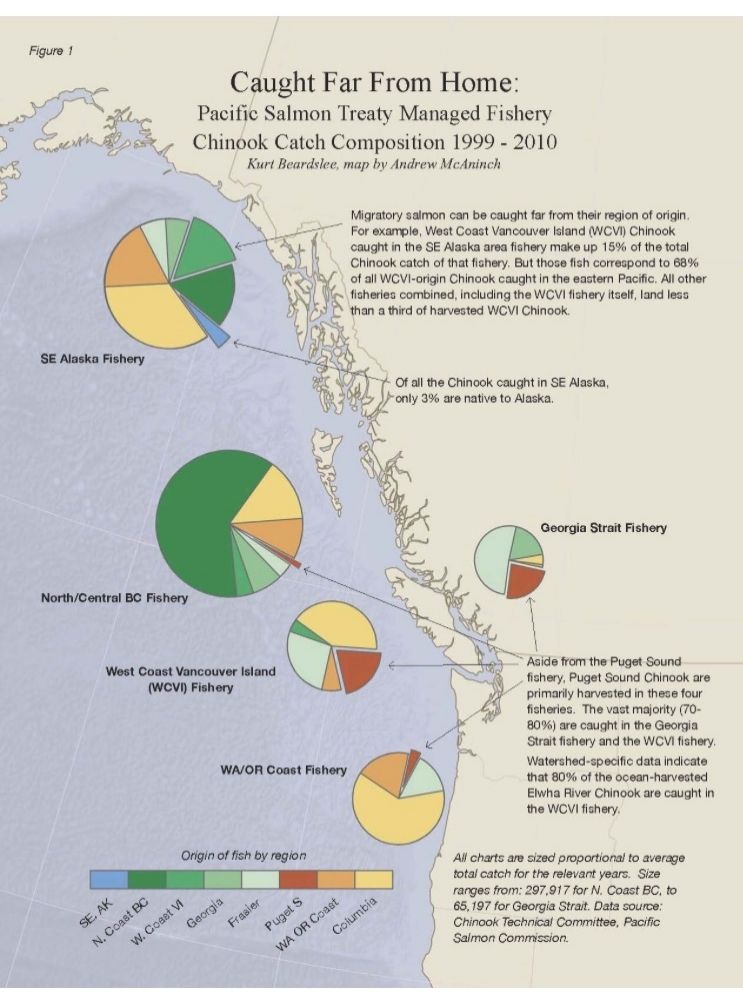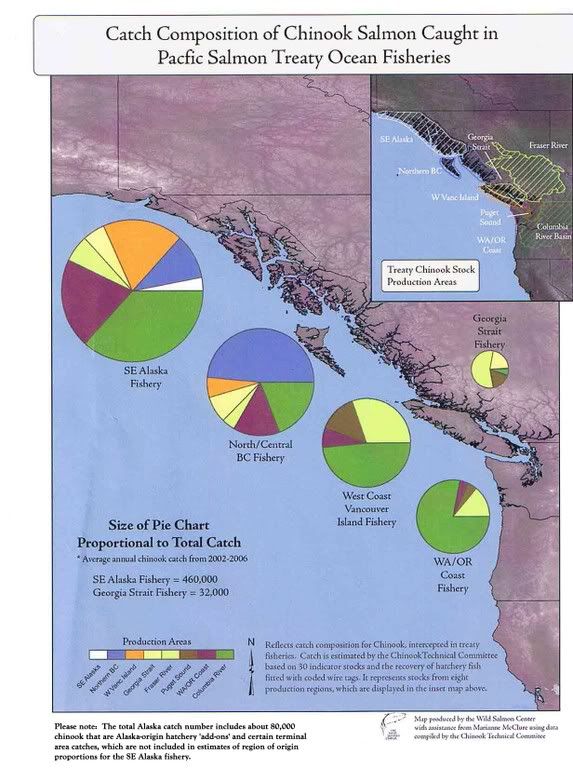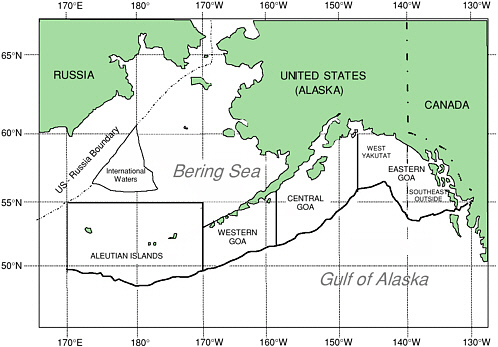I am posting up a recent letter from the Advocacy on the situation with ocean harvest. For the purpose of full disclosure Tim is my brother and I have known Ron & Art for years. Now to say my brother and I agree on everything is a reach in fact we often disagree LOUDLY. That all said his letter on ocean intercept hits the nail on the head. We as citizens have poured tax payer & our own money into habitat restoration, property setbacks, blockage removal, sewage just plain everything. For what? In order to restore salmon runs you have to let them come home and that is the issue. Until ocean intercept fisheries are addressed nothing will change. I will shut up now.
I have a graph that was done that shows that only 3% of salmon harvest ( Chinook ) in South East Alaska originate in Alaska. Yell if you want it. Also several other graphs the show the impacts and values.
For you GH folks I can also send you a graph showing the values of both the Rec inriver and bay fisheries.
Twin Harbors Fish & Wildlife Advocacy
PO Box 179
McCleary, WA 9855
thfwa@comcast.net
January 8, 2016
Pacific Salmon Commission via: email in PDF format 1155 Robson St.
Vancouver, BC V6E 1B5, Canada
Re: Request For A Reduction In Harvest Impacts
on Southern Bound Natural Spawning Salmon Stocks
The Twin Harbors Fish & Wildlife Advocacy is a non-profit organization based in Washington State. The purpose of the Advocacy is “Provide education, science, and other efforts that en- courage the public, regulatory agencies and private businesses to manage or utilize fish, wildlife and other natural resources in a fashion that insures the sustainable of those resources on into the future for the benefit of future generations.” (www. thfwa.org).
Advocacy members and their family and neighbors have personally spent decades investing in salmon production through volunteer projects that have raised millions of Chinook, Coho, and Chum salmon that contribute to the pool of fish caught in the Pacific Ocean. Our members and supporters have joined with other Washington citizens and property owners in contributing billions of dollars in habitat restoration, state operated hatchery production, culvert replacements, property devaluation, loss of timber harvest, municipal or private sewage and storm water improvements, etc. under government mandates wherein the stated primary purpose is the recovery or sustainability of natural spawning salmon stocks in WA streams.
With all this effort and investment, salmon recovery has struggled to succeed. Instate fishing has declined and ESA listings have plagued the state from the Columbia on the south to Puget Sound to the north.
Over the last 4 years, the Advocacy and others have invested thousands of hours in assisting the Washington Fish & Wildlife Commission in adoption of two new salmon management policies for the coastal terminals of Willapa Bay1 and Grays Harbor2. The policies prioritize conservation over harvest, install hatchery reform and place an increased emphasis on achieving escapement goals for natural spawning stocks. In simple terms, an all out effort is underway to avoid further ESA designations and return natural spawning production to numbers adequate to sustain viable fisheries in the future.
The effort underway went forth with the knowledge that harvest inside the terminal has to be managed in a manner that could often require reduction of harvest inside the two terminals in order to achieve escapement goals. Using 2015 as an example, tribal and non-tribal commercial
1
http://wdfw.wa.gov/conservation/fisheries/willapa_bay_salmon/2
http://wdfw.wa.gov/conservation/fisheries/grays_harbor_salmon/ seasons were curtailed for Chinook in Willapa and Grays Harbor. Recreational fishers in both terminals were forced to forgo retention of un-marked Chinook. Then, the much smaller than expected 2015 Coho return forced closures of tribal commercial, non-tribal commercial, and recreational seasons within both coastal terminals.
Even with all these measures and sacrifices, we believe it is clear escapement goals for natural spawning Chinook in Willapa Bay in 2015 were not reached. The adjustments in non-tribal and tribal fisheries inside the terminal, combined with a recent lowering of the escapement goal, might have allowed us to reach escapement goal for Chinook in Grays Harbor. We further predict that Coho escapement goals will not be achieved in either terminal even with the closures as once again the conservation burden fell on the terminal fishers who waited patiently for their turn to fish as harvest continued on schedule on the ocean.
We recognize that the citizens who live on and around salmon bearing streams are stewards of those streams and will pay a significantly greater price than non-locals for the production of fish that are likely to be harvested on the open ocean. However, in providing this subsidy to fishers in other regions, the harvest rate applied outside the terminals by PSC should not make it nearly impossible to achieve escapement goals or threaten the locals with additional burdens from ESA listing of species resulting from a consistent failure to achieve spawning production at a rate that insures the viability of the stock for the future. Unfortunately, such was the case in 2015 for Chinook in the Willapa and for Coho in both coastal terminals.
As an example of the hardship placed on those inside the terminal, on page 51 of PSC’s annual report on Chinook harvest (TCCHINOOK15-1_V1, PSC.PDF) it states in 2014 “....on average 86% of fishery-related mortality on WA coastal stocks” results from PSC sanctioned fisheries located north of the Canadian/WA border. Relating that mortality to Willapa Bay, the returning runsize of Chinook natural spawners coming across the bar into the Bay was below the escapement goal. In simple terms, the number of natural spawning Chinook heading for Willapa Bay was reduced by harvest in AK and BC to the point the runsize into the Bay was well below escapement making achievement of the escapement goal impossible even if all fishing inside the terminal was canceled. It is important to note that this phenomena is not limited to 2014, but rather the norm in Willapa for over a decade. Neither is it limited to just Chinook as the same shortfall in runsize below escapement goal occurred in 2015 for Coho in both terminals resulted in season cancellations though seasons on the ocean proceeded forward on the initial schedule.
In accordance with the Advocacy’s purpose referenced earlier, it is our belief that the elected officials and citizens of Washington state should have the opportunity to fully understand all the reasons why the billions already invested by Washingtonians have not produced the anticipated conservation results and the list of threatened or endangered stocks continue to grow in Puget Sound and elsewhere. It is therefore our intention to engage all in a long over-due discussion regarding the reasons why the state is plagued by the failure to recovery natural spawning salmon stocks.
The latest indicator of the need for such a broad based public discussion is the overfishing notice recently published by NOAA in the federal register for Willapa Bay and Grays Harbor fall Chinook and Coho in the Hoh River further up the coast. We believe the citizens will quickly ask
“Where is all this fishing occurring?” With 86% of fishing mortality occurring north of the WA/ Canada border, we expect most eyes to then turn to the PFC processes. The question we expect to hear is “If we can’t get PFC to let enough back to the streams to meet escapement goals, where’s the incentive for Washingtonians to continue pouring billions of dollars in public and private resources into habitat restoration and hatchery production?” At this point, the Advocacy doesn’t have an answer that we are confident the majority of citizens of Washington would find acceptable. Especially when responding to the family living on Willapa Bay that recently lost a quarter of a million dollars in harvestable timber due to setbacks intended to protect habitat for natural spawners that have yet to materialized in the nearby stream due to harvest impacts.
As we move forward in our project to engage all in discussions about how we can restore natural spawning stocks in Washington, the Advocacy respectfully requests that the Pacific Salmon Commission consider seasons north of Washington’s border for 2016 forward that reduces the impacts on natural origin salmon stocks that have either struggled to meet escapement goals or noted under ESA guidelines. In the case of Willapa and Grays Harbor Chinook and Hoh River Coho, we are requesting a decrease in northern impacts on natural spawners of 10% per year for five consecutive years or until such time as the number crossing over from the Pacific is expected to be at least 110% of the escapement goal for two consecutive years.
In presenting this request, we recognize that the Advocacy is not accustomed to the processes used within the Commission to establish quotas and harvest rates and some might frown on our approach. In our defense, at this point a relatively small percentage of Washingtonians even know the Commission exists let alone understand the impact the Commission has on the economic well-being of the state’s citizens. Then, the closed to the public meeting processes used by the Commission when establishing seasons north of WA do not provide the normal regulatory transparency we are accustomed to in the U.S. leaving one uncertain how to participate.
If anyone in the Commission has recommendations on how to participate in a more effective fashion, we will give all suggestions offered due consideration. In the meantime, we will be moving forward with our plans to engage the public and elected officials in a conversation about the difficulties and obstacles that need to be addressed to insure recovery of natural spawning salmon stocks in WA streams.
Respectfully,


















 Previous Topic
Previous Topic Index
Index

